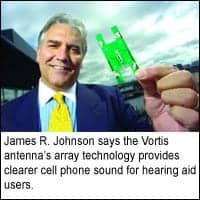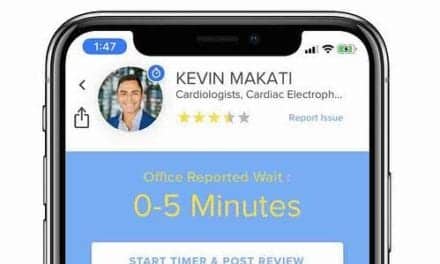
Q When and how did Vortis Technologies Ltd get started? What is the company’s specialty?
A The company was founded in San Francisco as Myers Johnson Inc and incorporated in 2001. It has been wholly acquired by Vortis Technologies Ltd (VTL), and is now based in Glasgow.
I understood enough about antennas and high technology, having worked in Silicon Valley, Calif, for 30 years, that any technology problem can be solved. When I saw that there was a 10-year-old issue [related to interference issues between cell phones and hearing aids] in the technology industry that was being somewhat ignored—even though the hearing industry was begging for service—I waited to determine if the industry was going to do anything, and nothing was done.
In speaking with [representatives] from Self Help for Hard of Hearing People [now the Hearing Loss Association of America] and the American National Standards Institute (ANSI) on the compatibility issue between hearing aids and cell phones, I saw there wasn’t a lot being done to help the hearing impaired.
I experienced the problem firsthand when I saw that my mother would have to turn down her hearing aid whenever the phone rang, and often would miss the call. I decided at that point that I would initiate a project, so I gathered engineers across the country, including my partner, Steven L. Myers, PhD, and we all collaborated on the development of an array antenna.
I understood enough about mobile phones and antennas to know that array technology has been under contemplation for years and under development. We decided to initiate the first array that would split the signal up and drive it in two directions, away from the hearing aid and the head, and thus provide enough reduction of interference so that they wouldn’t have the problem. We knew it would be good, in general, for cell phones, but we didn’t know the degree to which it would offer such advantages for overall use.
VTL has established a unique patent-protected circuit design for mobile phone and other consumer wireless devices. The passive, plug and play, disruptive array antenna technology is based on multiple elements instead of conventional single elements and will ultimately be embedded into handsets globally for mobile phones.
Q What were the concerns within the technology industry regarding interference issues?
A The primary concern was that the technology industry believed you needed to have an omnidirectional antenna for it to effectively operate on the system. We had to sort of position the knowledge out there that when an omnidirectional antenna is next to the head, it actually does become a directional antenna, and so, in reality, mobile phones have been directional since day one. That was a misconception in the industry.
They wouldn’t even test mobile phones with phantom heads in order to qualify them; they were testing them in what we call “free space.” They didn’t know what the end result would be until a 1996 study came out from Om P. Ghandi, ScD, at the University of Utah, with an Institute of Electrical and Electronics Engineers report that discussed the dosimetrics and interrelationship between the mobile phone and the human body. It basically says you lose 35% to 50% of the signal absorbed by the body—that’s quite a bit.
We knew of that, and we started to promulgate that message to the industry because they were reluctant to adopt our position of using a directional antenna to solve the hearing aid problem.
In testing, we discovered that because we don’t radiate directly into the head, because we have two elements, we actually do provide greater coverage than an omnidirectional single unit antenna.
Q Why has it been so difficult for hearing aid users to hear clearly when using cell phones? What are their main concerns?
A The digital pulse from the hearing aid is picked up by the mobile phone creating a “buzzing” sound. Hearing aid users want the same convenience and access as everyone else—the ability to pick up their handset and talk without having to use T-coils, necklaces, or other clip-on accessories.
The cell phone itself is probably one of the most difficult technologies to try to put together. It really is a vast array of technology. It begins obviously with the need to behave like a normal telephone, which is a speaker and a microphone; and then it has to go into software, which is digitally coded like telegraph signals going to the stations; it is a transmitter that has to transmit as long as possible, and a receiver that has to transmit and receive; it has to share the station with hundreds of other people at any one point in time, so it shares a time signal; and then in addition to that, you’ve got to make it look cute and small. All of those things combined really put some very serious constraints on very good engineers. They have made almost the impossible possible.
Having said that, the major limitation is the fact that all of it is put together in just one package. The key issue for people who are hearing impaired has always been signal-to-noise issues. To a hard-of-hearing person, when there’s background noise, it becomes even more difficult.
The strategy that the industry used years ago was the monopole antenna, which is really the major problem with any progress in clarity and power and everything else. The monopole antenna has to couple with the phone itself as its other counterpoise. It’s a good situation when you want to hide the antenna inside, and it’s a good situation when you want to reduce cost and when you want to balance out the effectiveness of everything else, but it obviously has limitations in terms of the nearfield radiating patterns—and that’s the area that we are specialists in.

When we create that configuration, it isolates the antenna because we’re mounted on the back. We isolate the antenna from the phone itself, and therefore, the signal-to-noise ratio is much wider. It just makes it clearer.
Typically, a mobile phone, when placed next to the head, will experience a 1 to 2 dB drop. What I have heard from our testing is the Vortis does not drop. I would have to say there must be some drop, but it’s nearly imperceptible. To be perfectly accurate, I’d say it’s hardly significant.
The Vortis antenna does not interact with the hearing aid at all. We may come out with a product that will interface with a T-coil that will have a separate signal in there that will help T-coil users. We’re sort of parting the Red Sea of RF (radiofrequency) energy so that the voice signal can walk through it without interference.

A The Vortis array technology reshapes energy surrounding mobile handsets into a “Figure 8” radiating pattern, where the head is located to the side and middle of the pattern. This unique pattern decreases radiated signal to the head and increases surrounding coverage for a user in the far fields. In doing so, it extends distance by reducing signal loss to the head with the following improvements: battery talk time is increased by 100% or more in fringe regions; improved coverage results in fewer dropped calls; signal clarity is improved by mitigating garbling and breakup in fringe regions; energy loss to the head is cut to the maximum achievable rates; and hearing aid users who previously experienced interference can use mobile phones.
The first problem is that many people with hearing aids experience an interference sound when placing the handset next to their hearing aid. This is because the antenna is radiating much of the energy into the person’s head and hearing aid. This is the second problem: Much of the energy is absorbed by the head and is wasted. To a small consumer portable device, this is a senseless configuration and a major drain on the battery.
Normal antenna patterns radiate outward in all directions, like when you toss a pebble into a pond. Much of this signal gets absorbed by the head, which makes the system less efficient. Our antenna is an array antenna of two small elements that operate out of phase with each other. Each one cancels out the other’s signal toward the direction of the head. Much like noise-canceling earphones, the science is called interferometry, with a base word interference. The two elements also enhance each other’s signal forward and rearward of the user to spread out wide as the signal reaches farther and wider to ultimately increase the overall coverage.
Tests show that if you don’t lose the energy to your head, you gain more energy toward the station, and thus save battery usage. In extreme cases, it is possible to get twice the battery talk time.
Q Who comprises the main customer base for this technology?
A The Vortis technology has been available for prototyping and field testing for about 2 or 3 years, but has not been commercially available until this year. The initial market for the Vortis is hearing aid users. This market will be expanded to include any mobile phone user who wishes to improve signal clarity, experience fewer dropped calls, and prolong battery life.
Q Is the Vortis available for all types of cell phones?
A At the moment, the Vortis is available only for the Motorola V550 series phones—in the United States, it’s known as the V557 from Cingular—and soon will also be available for the Motorola “Slivr” phones. That will be ready late summer.
Q Which end users would most benefit from this technology?
A Initially, the end user who will experience the most profound benefit is the hearing aid user. Ultimately, everyone will benefit from this advanced technology.
Q How has Vortis Technologies been involved with the Hearing Aid Compatibility Act? Would the technology help companies bring their products into compliance with the act?
A Yes. Vortis Technologies, as Myers Johnson Inc, worked with the United States Federal Communications Commission (FCC) and hearing aid organizations worldwide for 3 years with prototypes and testing.
In reviewing the issue, I saw that there was a number of correspondence and records on the interaction between hearing aid organizations and the FCC. In 2001, the FCC opened up a notice of proposed rule making (NPRM). Basically, whenever they want to change a rule, they open it up to public debate. They opened this up in 2001, and we made our first filing in 2002; the hearing aid and mobile phone industries were basically stating that the problem was going away and would no longer be a major issue and nothing had to be done about it.
I commissioned a study of 47 hearing aids. I put our study together with the real market data and discovered that 50% to 60% of the industry had the problem, and said to the FCC that they could go ahead and state that it’s going away, but in reality, in the pool out there of 6 million users, you’ve got 2 to 3 million users with the problem. According to the rate of change in the industry, it’s not going to go away for several years.
I think that changed a lot of minds. When you present an argument like that, it’s difficult for anyone to counter it, unless they’ve done their homework; I think the absence of counterarguments caused the FCC to start looking at it more seriously as a real problem today that’s not going away.
Then, the industry basically said, “You need omnidirectional. There’s no way you can mitigate the RF signal because this is a mobile phone and it has to radiate the signal; that’s what it does.” We made it clear that array technology was the technology of the future, and that what they were stating was not correct. You can reshape the energy. We brought prototypes to the FCC and demonstrated it.
Q What is the company working on for the future?
A Ultimately, the embedding of the advanced Vortis technology into all mobile handsets.
There’s a lot of movement in FM connection between the hearing aid and remote microphones. We believe that there’s a good market for placing a remote FM microphone into the Vortis. Instead of placing a microphone down on the table, you would just place the Vortis down and it would pick up the sound and essentially generate it back into the T-coil. There’s a lot of stigma associated with these accessories, which is why we’ve made the Vortis as easy to look at as possible; instead of putting a microphone down, which might have a stigma associated with it, placing your cell phone with the Vortis in it on the table isn’t as intimidating.
When you help people with better hearing, you actually are creating new technology for everybody. It really does lead the technology curve.
The technology for the Vortis is the right technology for cell phones. The clarity that the Vortis can bring to the cell phone is better than any other antenna can bring. Not only does it help hearing aid users, but it helps all of the individuals who consider themselves hard of hearing, and that’s something like 10 times more than hearing aid users.





